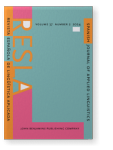Vol. 37:2 (2024) ► pp.371–395
Vol. 37:2 (2024) ► pp.371–395
Collocations of fictive motion verbs in adventure tourism
A corpus-based study of the English language
This paper investigates the collocations produced by a set of fictive motion verbs found in a specialized corpus representing the language of adventure tourism. Since our ultimate aim is to contribute to the characterization of this specialized language, we defined two specific objectives: (1) to analyze the motion verbs and their meanings extracted from the Advencor corpus, and (2) to identify the collocates of these verbs as well as the semantic roles they express. After the application of our methodology, eight motion verbs produced 35 collocations satisfying all the established criteria. The results focus on different aspects: (1) the verbs convey distinct meanings, such as motion on a vertical axis or direction towards a destination; (2) the most recurrent combination is noun + verb, where the former describes the inanimate entity that seems to perform motion; (3) collocation production and collocation strength are not correlated; and (4) the collocates accompanying the verbs under analysis shed light on the argument structure of these verbs, for they represent one of the participants. In conclusion, this work provides relevant information about the phraseology of fictive motion verbs in the language of adventure tourism and proves the specialization of this domain.
Article outline
- 1.Introduction
- 2.Characterizing collocations
- 2.1Features and types
- 3.Specialized collocations: Their role in the language of tourism
- 4.Methodology
- 4.1Extraction and selection of motion verbs
- 4.2Extraction of collocates
- 4.3Identification of fictive motion in collocations
- 5.Results
- 5.1Analysis model: climb-v
- 5.2Analysis of results
- 6.Conclusions
- Notes
-
References
